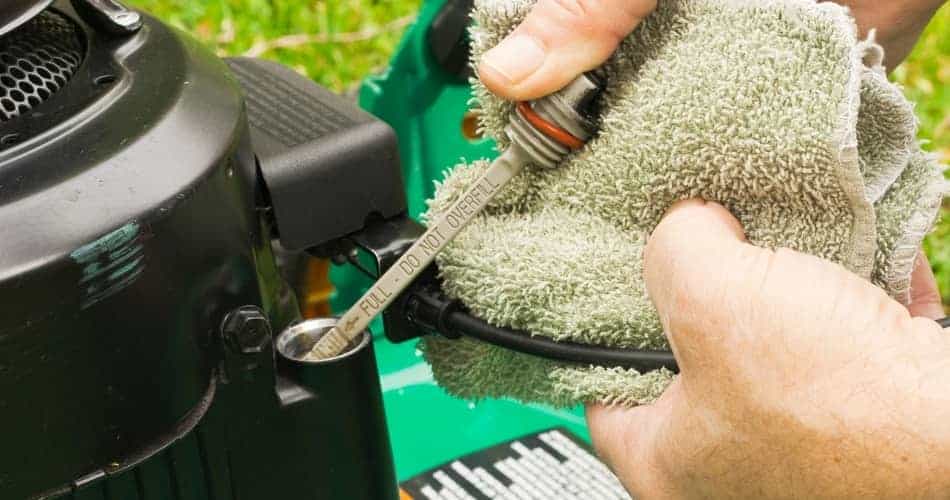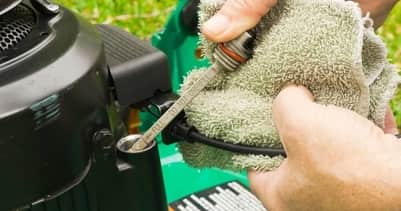So you got in a hurry and added too much oil to your lawn mower engine. No big deal right? Wrong.
The manufacturer provides a recommended amount of oil needed for your engine. So why add more than that? If you find yourself doing this, this could happen to your engine.
Too much oil in your lawn mower may cause the engine to not run well and cause damaging results. Too much oil can cause your engine to overheat which can result in seal damage, blown gaskets or becoming hydrolocked.
Here are descriptions of problems you may encounter if you put too much oil in your engine. If you are lucky, the result can be somewhat minor with run ability issues that can be addressed by fixing the oil levels.
If you are not that lucky, you can cause damage that may result in significant engine work or even an engine replacement.

This post may include affiliate links. Purchases made through these links may provide a commission for us, at no extra cost to you. As an Amazon Associate, we earn from qualifying purchases.
Follow all safety instructions provided in your equipment operator’s manual prior to diagnosing, repairing, or operating.Consult a professional if you don’t have the skills, or knowledge or are not in the condition to perform the repair safely.
Effect of Too Much Engine Oil in Your Lawn Mower
1. Engine Seal Damage
You could damage the oil seals in the engine. This does not sound like significant damage, but if oil blows out of the seals, and you don’t catch it, you can blow up the engine by running out of oil.
When you run out of oil, the excessive heat of the engine will most likely spin a rod or weld itself to the crankshaft.
This heat can also break the rod and send it out to the side of the engine block. The piston can weld itself to the inside of the cylinder causing it to seize up.
2. Engine May Overheat
You can overheat the engine when the crankshaft and rod have to push through more oil. The crankshaft and rod are not able to rotate freely with the extra oil.
In turn, the crankcase pressure increases and puts the internal working parts of the engine under load.
The valve spring and rocker arm will get hot. The oil might not flow properly which can create more heat. You must remember most engines are built out of aluminum which gets very hot.
The engine can get so hot it can pop out a valve guide or a valve seat from the engine block. If this happens to your engine you will need to have your engine scraped out.
3. Engine May Lock Up
When the oil is overfilled it may also find its way into the cylinder. This makes the engine turn over very hard. If the oil gets past the rings, due to wear, it could lock up the engine. This is what is known as hydrolocked.
What this means is the combustion chamber, which should only have air and a small amount of fuel in it, now has oil in it.
With the added compressions, the piston cannot compress the oil and it becomes hydrolocked. When this happens you can bend the piston rod when you go to start the engine.
4. Engine May Not Run Well and Smoke
Sometimes when there is too much oil in your engine it will run, but not very well. Too much engine oil can get up to the spark plug and foul out the plug.
The oil inhibits the spark that is needed to fire the fuel properly. Another reason why your lawn mower may not run well is that oil can find its way into the valve train.
This oil gets burned in the cylinder and you will find yourself in a thick cloud of whitish blue stinky smoke.
In addition to the smoke, your air filter can plug up if the engine can’t pull in clean air. The engine may pull crankcase air and oil causing the air filter to plug.
5. Engine May Blow Gaskets
The engine problems from overfilling with engine oil are mostly the same in twin-cylinder engines. The excessive heat from overfilling may blow gaskets.
Replacing gaskets on a twin-cylinder engine is more expensive than repairs on a push mower engine because you will have to remove the engine from the lawn mower resulting in additional labor costs.
Adding a little additional oil may not seem like a big deal, but it is actually a huge deal that can result in requiring a significant repair or an engine replacement.
So when doing oil changes or adding oil look twice and only add what is required by your engine manufacturer and don’t assume a going over the required amount will be okay.
How to Remove Excess Oil From a Lawn Mower
If you overfilled your engine oil, you need to get the oil down to the correct level. The first thing you need to do is remove the spark plug wire for safety. There are several different ways to remove engine oil from your lawn mower.
- Drain Plug or Valve Port: You need to find the drain plug or valve port on the engine if your lawn mower has one. It may be found on the side of the engine by the dipstick or at the bottom of the oil pan under the lawn mower.
Have your drain pan ready to collect the oil. Remove the plug for a quick second and replace it. Check your oil level.
- Oil Filter: If your engine uses an oil filter, you can drain a little oil by loosening or removing the oil filter to drain a little oil. Have a rag ready to collect the oil.
- Fill Hole: Your mower may not have a drain plug or oil filter. Many small engines on push mowers do not have a drain plug and you have to tip the mower over to drain a little oil out of the fill hole.
- Oil Extractor Pump: An oil evacuator works well to remove oil. An extractor will remove oil through a tube inserted into the engine oil fill hole.
- Turkey Baster: A turkey baster works well for removing small amounts of oil. Just make sure you don’t reuse it for cooking purposes after using it in your engine. These are pretty inexpensive to replace.
How to Not Overfill Oil in a Lawn Mower
Before you change your lawn mower’s engine oil you need to look at your owner’s manual to find your engine oil capacity.
If you don’t have your owner’s manual, you can always use Google or the search engine of your choice to find the crankcase capacity.
Most small engines on push mowers will take about 3/4 of a quart of motor oil. A v-twin engine will usually take approximately 2 quarts.
A larger lawn mower commercial engine known as a big block can take 3 quarts of engine oil. These larger engines are known to be about 34 horsepower or larger.
The best way not to overfill your engine oil is to know your crankcase capacity and only add 1/2 quart of oil at a time. Keep checking the oil until you hit your mark.
If you are adding 1/2 quart at a time, when you get close to being fun, just add a little bit at a time and check the oil level on your oil gauge or dipstick.
Will Too Much Oil Prevent a Lawn Mower from Starting?
Too much engine oil can prevent your engine from running. The oil pan on the small engines used on lawn mowers is very small.
There is not much room for error with such a small space. If you put too much oil in an engine your engine can hydrolock.
Hydrolocking is when oil gets up into the cylinder and past the piston. The oil then fills up the combustion chamber not allowing the piston to move to the top of the combustion chamber.
The piston is designed to compress air and not oil or water. When you pull on the rope or start the engine with a starter the oil will not compress and it won’t let the piston move. This is referred to as being hydrolocked.
Too much oil can also foul out the spark plug and not allow the engine to run. Another damage too much oil can do to an engine is oil getting into the carburetor through the valve train causing the engine not to run.
This oil can pass through the carburetor and into the air filter which will also cause your engine not to run.
Here are a few items I like to keep on hand when I service or troubleshoot my lawn mower:
Still Having Problems with Your Lawn Mower?
Lawn mower ownership doesn’t come without its frustrations. Own a lawn mower long enough, you are bound to run into many lawn mower problems including starting, smoking, leaking, cutting, and overheating.
For a list of the most common lawn mower problems and items that can cause them, check out my guide “Common Lawn Mower Problems: Solved!“
